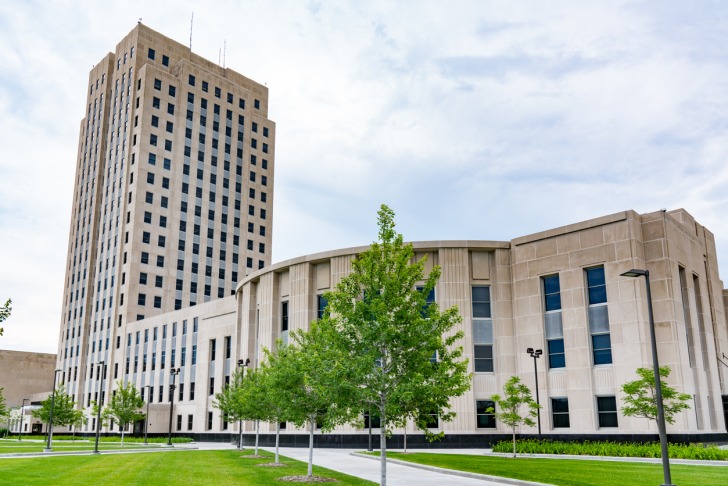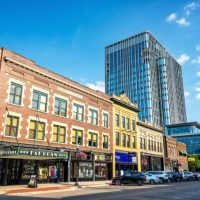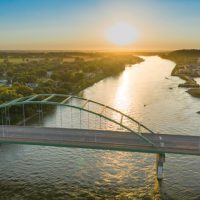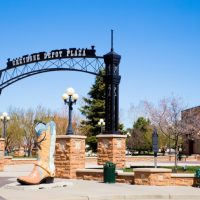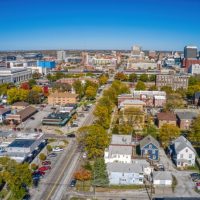Bismarck, North Dakota is the state capital, in the western-central part of the state.
It is relatively isolated but has a lot of positive aspects as well.
There are lots of outdoor recreational activities and the overall quality of life is very good.
The winters are very harsh, and if you can stand the cold, the city might be a perfect place to settle down.
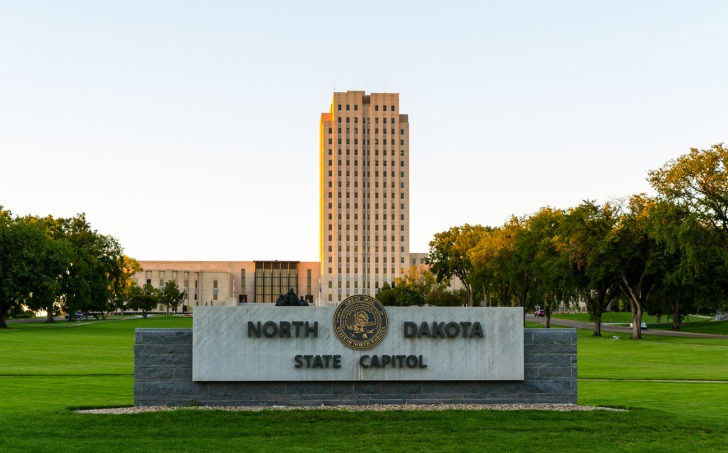
Contents
Pros of Living in Bismarck, North Dakota
1. The Great Outdoors
The Missouri River flows through the town, which offers a plethora of outdoor activities – such as boating, fishing, skiing, and ice fishing in winter.
Snowshoeing and snowmobiling are great wintertime activities.
In summer there is hiking, hunting, and even more fishing.
Theodore Roosevelt National Park is not far away, and there are many more parks in the immediate area.
The Missouri River marks the end of the prairie and the beginning of western hills and mountains.
2. The Overall Quality of Life
If you love nature and the great outdoors, Bismarck will be a great place to live.
Even with a harsh winter, there are plenty of outdoor activities to enjoy.
The cost of living is higher than the rest of the state, but still at the national average.
The city is clean, has low unemployment, and is not particularly crowded.
There is a strong arts scene, and it has all the amenities you need in a city.
Schools are highly rated, the crime rate is low, and there are diverse cultures.
3. A Growing City
Bismarck has grown by at least 10 percent, and oftentimes more than 20 percent, in each decade of its existence.
100 year ago it had about 10,000 people, and in 2023 it had 75,000.
It has doubled in size since the mid-70s.
The steady growth is a sign that people like the city, and it is able to attract new people.
4. Low Unemployment and Poverty Levels
About five percent of Bismarck’s population lives below the poverty level.
The national average is 11-13 percent.
Unemployment is also very low, at 1.1 percent, and it was 1.8 percent last year.
The national average is about four percent, and anything below two percent is considered full capacity.
One reason is the lower population levels meaning there are fewer people competing for jobs.
The entire state is around two percent unemployed.
5. The Food Scene
Bismarck is a bit isolated from the rest of the world.
One benefit of that is people developing their own cuisine.
There are local favorites like Knoephla soup – which is a thick chicken or potato soup.
There are specialized fish dishes focused on Walleye, and they also have their own version of pizza.
Steaks from locally from cows, or bison, are also outstanding.
Many people are of European descent, but there are many international foods represented here as well.
6. Strong Sense of Community
People in Bismarck take a lot of price in their city, and there is a lot of community involvement in keeping it a pleasant place to live.
There are several festivals throughout the year to celebrate things that are important to local people.
Generally, people are friendly to outsiders, and welcoming to people moving there.
It won’t take you long to feel like you are part of the community.
7. Good Schools
Bismarck State College offers a sound education and plenty of opportunities for continuing education.
While not in Bismarck, North Dakota State is one of the top agriculture schools in the nation, and the University of North Dakota is a well-respected liberal arts school.
Local schools, grades K-12, get high marks as well for providing quality education.
Education is not expensive for North Dakota residents.
8. Cost of Living
Bismarck is one of the more expensive places to live in North Dakota, but it is still lower than most of the rest of the nation.
Housing is about three percent below the national average, and groceries are about five percent lower.
Utilities are about three percent above the national average.
There are plenty of jobs, but wages are not particularly high.
The average hourly wage is just a few percentage points below the national average.
The cost of living is not incredibly low then, but it is lower than in many parts of the country.
Cons of Living in Bismarck, North Dakota
1. Winter
Just as in the rest of the state, Winter is the hardest thing about living in Bismarck, North Dakota.
Snow may start falling in early October, and there will be snow on the ground through the following March or April.
Winters are very cold, with weeks below freezing, and below zero with wind chill.
There are winter sports available, but even locals do not totally get used to the extreme winters here.
2. It’s a Long Way to Anywhere
If you want to go to another city, you will be in for a long car ride – for hours.
There are some Interstates, but they don’t cover all the states.
You will have to plan your routes on two-lane roads for the most part.
The airport is small and has no direct flights to major cities.
Because of the distance involved, travel takes longer and costs more than in other areas of the country.
3. Isolation
Bismarck has created a nice comfortable community for itself, but it is isolated from the rest of the world.
This may be a positive for some people, but it is a negative for people who want to be connected to the rest of the country.
You can begin to feel like the rest of the world is passing you by.
The Internet has changed the level of connectivity, but there is still a feeling of isolation at times in remote cities.
4. Time Zones
Bismarck is in Central time, and the Missouri River which borders the two, marks the beginning of Mountain time.
This means the city of Mandan, just across the river, is in a different time zone.
There has been a move to move the time zone a bit to the west, but so far it has not succeeded.
Local people have adjusted, and it does not cause a lot of confusion for local residents.
It does seem like it would be confusing though, to have an hour’s difference in time just a few miles away.
5. Boring Nightlife
Compared to larger cities, you may think Bismarck has a boring nightlife.
There are bars, restaurants, and music venues to enjoy, but there are not a lot of them.
There are none that will be open all night long.
There are not a lot of exciting nightclubs either.
The city closes down at some point during the night, and some people will find that boring.
A lot will depend on where you come from.
If you are coming from a big city like Chicago, New York, or Los Angeles, the nightlife will seem pretty boring.
6. Lack of Diversity
Bismarck is 86 percent white, and many of those people are of Germanic descent.
About five percent are Native American, and three percent are Black, or African American.
While there is a strong sense of community and familiarity, there are not a lot of different cultures represented.
You will not be exposed to as many different worldviews as you would in many other cities.
There is also a lack of diversity when it comes to the economy.
Most of the economy is focused on agriculture and energy.
7. Lower Paying Jobs
There is very little unemployment in Bismarck, or in the entire state of North Dakota.
Bismarck is focused on agriculture, government, and energy.
If you have skills in those areas you will do well, but if you do not, you may have a hard time finding a good-paying job.
The average hourly wage in Bismarck is $26.00, which is 11 percent below the national average.
With costs being at the national average, that means many people in the city have less buying power.
8. Crime Rate
The crime rate in Bismarck, North Dakota is a mixed bag.
The violent crime rate is slightly below the national average and at the same level as the state.
Property crime, however, is nearly double the national average and far above the state average.
There are 35 property crimes per 1,000 people, as opposed to 19 at the national level, and 22 at the state level.
Motor vehicle theft, as well as theft in general, are both double the national average.
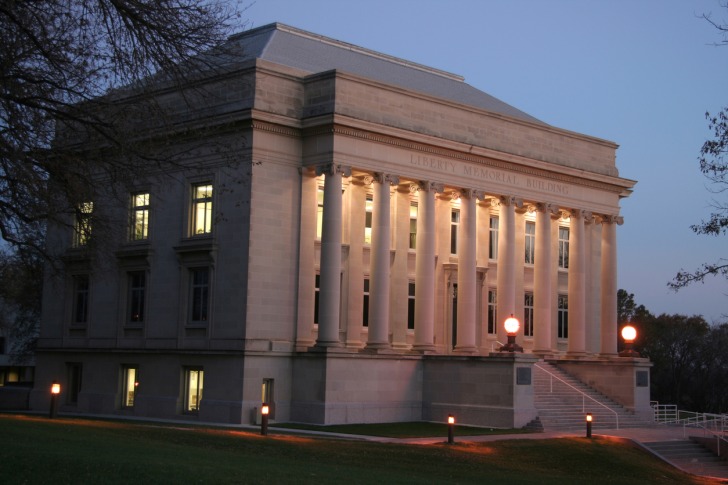
Pros and Cons of Living in Bismarck, North Dakota – Summary Table
| Pros of Living in Bismarck, North Dakota | Cons of Living in Bismarck, North Dakota |
|---|---|
| 1. The Great Outdoors | 1. Winter |
| 2. The Overall Quality of Life | 2. It's a Long Way to Anywhere |
| 3. A Growing City | 3. Isolation |
| 4. Low Unemployment and Poverty Levels | 4. Time Zones |
| 5. The Food Scene | 5. Boring Nightlife |
| 6. Strong Sense of Community | 6. Lack of Diversity |
| 7. Good Schools | 7. Lower Paying Jobs |
| 8. Cost of Living | 8. Crime Rate |
Bismarck Safety Overview
READ THE FULL REPORT: Bismarck Safety Review
Safety Index: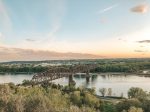
- OVERALL RISK: LOW
- TRANSPORT & TAXIS RISK: LOW
- PICKPOCKETS RISK: LOW
- NATURAL DISASTERS RISK: MEDIUM
- MUGGING RISK: LOW
- TERRORISM RISK: LOW
- SCAMS RISK: LOW
- WOMEN TRAVELERS RISK: LOW
Frequently Asked Questions
What is unique about the state capital building in Bismarck?
The state capital building is a 21-story skyscraper.
It is by far the tallest building in Bismarck and the tallest building in the state.
You can see the building from almost anywhere in the city.
The capital grounds are beautifully landscaped and maintained.
Some see the capital building as unique, while others see it as an eyesore.
Who are the biggest employers in Bismarck?
Bismarck public schools are the largest employer in the city, taking care of thousands of students in grades K-12.
Energy, health, and state government jobs are the next largest employers in the city.
Is there dangerous wildlife in North Dakota?
North Dakota has a lot of wild unspoiled areas, some very close to Bismarck.
In these areas, Bison, Moose, and Deer roam freely.
They cross roads whenever they want to, and cause traffic hazards for motorists.
Bison can be aggressive and dangerous, so you need to keep your distance.
In the western part of the state, there are rattlesnakes.
How long does winter last in Bismarck?
Typically, snow starts falling in mid-October, and there can be snow as late as April of the following year.
There has been measurable snowfall in every month except for August.
In 2022, Bismarck set a new record with 155 days of at least one inch of snow on the ground.
Winter lasts for about six months.
How much snow does Bismarck get?
The city gets an average of 50 inches of snow per year and got 55 inches in 2022.
The all-time largest snowfall happened in 1996 when 101 inches fell over the winter.
The biggest storm on record was in 1966 when a blizzard with 70-mile-per-hour winds lasted four days.
There were parts of North Dakota that had 40-foot-high snow drifts.
How did Bismarck get started?
The city was founded in 1873 and incorporated in 1875.
The town was in a strategic location for steamboats going up and down the Missouri River.
When the railroads expanded westward to this area, the town became even more important for settlers.
